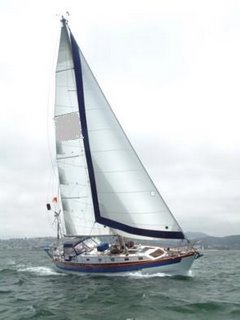Mystic Seaport, CT 13 August 2007

We spent the day in Mystic Seaport Museum/Park. They have restored several tall masted schooners that were built in the 1800's. They have not only restored ships but the park is made up of restored buildings that you would have seen in the 1800's such as the ship stores, clock maker, pharmacy, how ropes/lines were made, and how the wooden ships, mast, keels etc. were made. This is a "living museum" because they are restoring many types of wooden fishing vessels and replicating ship figureheads etc.
 In the afternoon they had a demonstration of how the sails were hulled up the mast, how the ships dingy was lay ed over the side of the boat and then hauled back up-all by block and tackle and a mechanical windless. As the crew worked they sang sailing ditties so the work was done in a smooth uniform way.
In the afternoon they had a demonstration of how the sails were hulled up the mast, how the ships dingy was lay ed over the side of the boat and then hauled back up-all by block and tackle and a mechanical windless. As the crew worked they sang sailing ditties so the work was done in a smooth uniform way. This is the Charles W. Morgan which is the last wooden whaling ship that was built in 1841. We went inside the vessel and saw the captain's and officers quarters, the storage area for the barrels of whale oil and even the ship's roster. Many of the sailors were from the Azores, Spain, Portugal. This ship sailed out of San Fransisco and would frequently spend 4 or 5 years out before returning to the USA. I just finished reading "Whaling Letters" Published by the Descendants of Whaling Masters which gives a good depiction of life aboard as well as the families left at home. On the Charles W. Morgan the captain's wife and daughter lived aboard on some cruises.
This is the Charles W. Morgan which is the last wooden whaling ship that was built in 1841. We went inside the vessel and saw the captain's and officers quarters, the storage area for the barrels of whale oil and even the ship's roster. Many of the sailors were from the Azores, Spain, Portugal. This ship sailed out of San Fransisco and would frequently spend 4 or 5 years out before returning to the USA. I just finished reading "Whaling Letters" Published by the Descendants of Whaling Masters which gives a good depiction of life aboard as well as the families left at home. On the Charles W. Morgan the captain's wife and daughter lived aboard on some cruises. We also watched a life saving rescue. If the ship floundered on the rocks, lines were shot to the boat's mast and the sailors were retrieved in this life saving ring and hauled back to land.
We also watched a life saving rescue. If the ship floundered on the rocks, lines were shot to the boat's mast and the sailors were retrieved in this life saving ring and hauled back to land. This device saved countless lives and is modified in modern times when a helicopter can't retrieve the men because of sea conditions.
This device saved countless lives and is modified in modern times when a helicopter can't retrieve the men because of sea conditions. After saving the crew, the lines were "flaked" so the line could be thrown without without for the next rescue without snagging.
After saving the crew, the lines were "flaked" so the line could be thrown without without for the next rescue without snagging.The museum had a great many photographs of fishermen and their sailing vessels.




0 Comments:
Post a Comment
<< Home